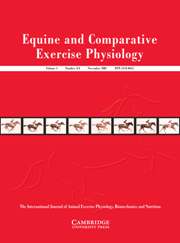Article contents
Pre-race warm-up practices in Greyhound racing: a pilot study
Published online by Cambridge University Press: 01 November 2007
Abstract
Despite the high athletic demands of Greyhound racing and recommendations for the inclusion of pre-race warm-up by some veterinarians, the extent of warm-up practices by Greyhound owners and trainers remains unexplored. We postulated that little pre-race warm-up occurred and any warm-up activities were performed at random. A cross-sectional study design was used to examine pre-race warm-up practices in a sample of 80 Greyhounds. Warm-up components were recorded and scores were assigned in order to quantify the total amount of warm-up undertaken. Associations between total warm-up and signalment and race characteristics were analysed statistically. Correlations between total warm-up performed and all variables including race distance, race order, grade of Greyhound and trainer were poor (all r < 0.2). No statistically significant association between total warm-up and any variable examined could be demonstrated at the P = 0.05 level, although a weak trend towards graded Greyhounds performing more warm-up was noted (P = 0.09). We conclude that little pre-race warm-up is performed in Greyhounds and that when practised, the amount and methods of warm-up are inconsistently applied.
Information
- Type
- Short Communication
- Information
- Copyright
- Copyright © Cambridge University Press 2008
References
- 2
- Cited by

